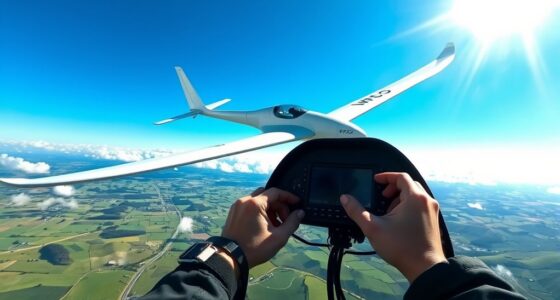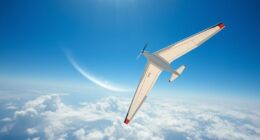To improve your contest flying, focus on precise navigation, quick decision-making, and thermal optimization. Use your instruments effectively to plan routes, avoid unnecessary detours, and stay aware of environmental cues like landscape and wind shifts. Maximize soaring by finding and using thermals efficiently, conserving energy, and climbing quickly. Combining these tactics helps you stay higher longer and reach turnpoints faster. Keep refining these skills, and you’ll gain a competitive edge that sets you apart.
Key Takeaways
- Develop precise route planning to minimize detours and ensure quick, accurate turnpoint navigation.
- Exploit thermals efficiently by reading landscape cues and adjusting altitude promptly.
- Use instruments like GPS and altimeters for real-time position tracking and navigation accuracy.
- Maintain high situational awareness to adapt strategies rapidly to changing environmental conditions.
- Focus on quick decision-making and technical mastery to optimize flight efficiency and overall race performance.

Have you ever wondered what separates winning flight strategies from the rest? It’s often a combination of precise planning, quick decision-making, and technical mastery. When it comes to contest flying, mastering tactics like thermal optimization and navigation accuracy can make all the difference. These elements aren’t just technical details; they’re the foundation of efficient, competitive flying that can propel you ahead of the pack.
Thermal optimization is about getting the most out of the rising air currents you find during your flight. Instead of chasing every visible cloud or relying on guesswork, you develop an instinct for reading the landscape, wind shifts, and subtle signs that indicate thermals. This skill allows you to ascend quickly and gain altitude with minimal effort, conserving your energy and reducing flight time. The key is to continuously adjust your altitude and position based on real-time environmental cues, maximizing your chances of catching strong thermals and avoiding weak or sinking air. When you optimize your thermals, you spend less time circling and more time progressing toward your turnpoints efficiently.
Master thermal reading and adjustment to ascent efficiently and save flight time.
Navigation accuracy is equally vital. You need to know exactly where you are at all times and plan your route with precision, using GPS, altimeters, and other instruments. This accuracy ensures you don’t waste time taking unnecessary detours or missing key turnpoints. It’s about maintaining a clear mental map of your route, constantly updating your position, and making swift adjustments when conditions shift unexpectedly. A small miscalculation in navigation can lead to significant time losses, especially in a race where every second counts. Practice makes perfect—familiarize yourself with your instruments, study the course beforehand, and develop a routine for quick, confident navigation.
Combining thermal optimization with precise navigation creates a powerful synergy. When you efficiently locate and exploit thermals, you can maintain a steady pace, stay higher longer, and reduce your overall flight time. Accurate navigation ensures you stay on course, avoiding unnecessary detours that drain your energy and time. Additionally, staying informed about local conditions can help you adapt your strategies more effectively. Together, these tactics allow you to fly smarter, not just faster. They demand focus, discipline, and a keen awareness of your environment but pay off by giving you the edge over competitors who may overlook these details. Ultimately, mastering these skills transforms your flying from merely good to truly competitive, helping you dominate the contest and achieve victory.
Frequently Asked Questions
How Do Weather Conditions Influence Contest Flying Strategies?
Weather conditions directly impact your contest flying strategies. You should analyze weather patterns to determine the best routes and timing. Wind influence affects your speed and turnpoint approach, so plan accordingly to optimize lift and minimize drift. Be flexible and adapt your tactics based on changing conditions. Adjust your altitude and flight path to take advantage of thermals and avoid turbulent areas, ensuring you stay efficient and competitive throughout the race.
What Equipment Enhancements Can Improve Turnpoint Accuracy?
Think of your aircraft as a ship steering a vast ocean; upgraded instruments and advanced navigation aids are your compass and lighthouse. By investing in modern GPS systems, gliders with precise altitude and speed sensors, and reliable turnpoint tracking devices, you can improve your turnpoint accuracy. These enhancements help you steer confidently, avoid delays, and stay on course, transforming your flight into a well-charted voyage where every turn brings you closer to victory.
How Should Pilots Adapt Strategies for Different Contest Formats?
You should adapt your strategies for different contest formats by staying flexible and adjusting your approach based on the specific rules and objectives. Emphasize contest format adaptation by analyzing the scoring system, task type, and terrain. Maintain strategy flexibility, allowing you to switch tactics quickly if conditions change. This proactive approach helps optimize your performance across various formats, ensuring you remain competitive and able to capitalize on opportunities as they arise.
What Are Common Mistakes Made During High-Speed Racing Segments?
During high-speed racing segments, you often make mistakes like misjudging distances or pushing too hard, leading to pilot fatigue. You might also overshoot turnpoints or accelerate prematurely, losing valuable time. To avoid these errors, stay focused, pace yourself, and double-check distances. Recognize signs of fatigue early, take brief rests if needed, and maintain situational awareness to keep your performance sharp and avoid costly mistakes.
How Do Beginners Develop Effective Contest Flying Tactics?
To develop effective contest flying tactics, you should focus on thermal planning and altitude management. Look for rising air to gain altitude efficiently, saving energy for key turns and speed sections. Practice reading the sky and predicting thermal locations. Manage your altitude carefully to avoid unnecessary climbs or descents, ensuring you stay competitive throughout the race. Consistent practice and analyzing your flights will help you refine these tactics over time.
Conclusion
Remember, every turnpoint is a doorway to mastery, each maneuver a brushstroke on your canvas of skill. Embrace the challenges as the wind’s whisper, guiding you toward excellence. With strategic flying, you become the captain of your destiny, steering through the sky’s infinite tapestry. Let your tactics be the compass, your focus the lantern illuminating the path. In this dance with the clouds, you forge not just a race, but your legacy among the stars.
With a heart that soars as high as the skies, Aria, affectionately known as “Skylark,” is the driving force behind Soaring Skyways. Her journey into the gliding world began as a young dreamer gazing up at the soaring birds, yearning to experience the weightlessness and freedom they embodied. With years of experience both in the cockpit and behind the scenes, Aria’s commitment to the gliding community is unwavering.









